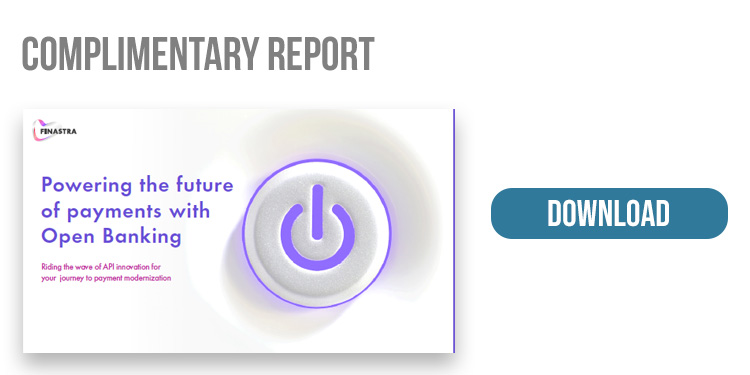Between the demand for personalized services from customers and the rise of fintech service providers, banks have a lot of work to do. The movement toward APIs happened seemingly overnight, and there’s no signs of turning back. In the not-so-distant future, open banking will be the new norm.
In a recent report by Finastra, Powering the Future of Payments With Open Banking, experts discuss how banks can hop on the API train for a journey toward payment modernization.
A gateway to new kinds of payments
Open banking is a gateway to new kinds of payments, but it is still a relatively new concept. Open banking began with the Second Payments Directive (PSD2) and account aggregation. Now banks are working to further innovate beyond the basic requirements and expand into the fintech ecosystem.
At first, many banks limited themselves by only offering APIs within the mandatory scope, seeing the regulations as mere requirements rather than an opportunity to use new technology to innovate and grow. However, with the acceleration of digitization brought on by the global pandemic, banks have been forced to look at open banking with fresh eyes.
If banks want to remain relevant in a sea full of fintechs, they need to rethink how they deliver financial services. When working on a new channel or service, it is important to consider how the same thing can be accomplished with an API. This is something big techs have been doing for decades, and now banks too can positively impact the market through data sharing.
Ecosystem requirements for successful open banking
In order for open banking to operate successfully, there are four ecosystem requirements that must be met:
- APIs thatcan leverage and authorize third-party developers to give them access to data and banking systems.
- Enabling assets thatallow open access to data.
- Use cases thatare a driving force for payment innovation.
- Partnerships with fintechs that will help to accelerate innovation and provide financial institutions with the technology, expertise, and vision needed to drive open banking value creation.
Models that are executed successfully achieve continued demand and supply from the ecosystem, which creates a “network” effect. Finastra offers access to their payment APIs through its FusionFabric.cloud platform, and their solution guarantees fine grain entitlement management.
A roadmap to open API enablement
Let’s face it: some degree of back office reinvention is necessary to take full advantage of front-office, open APIs. But how are banks supposed to get there?
APIs are a challenge to the traditional structural approach, so banks need to carefully consider their courses of action before making any decisions. There is always the risk of putting extra strain on an already complex payment silo landscape.
There are two questions banks should ask themselves before implementing any new technologies:
- Can they adapt their current channel, middleware, and back-office systems to the demands of open API access?
- Do they need a completely new approach?
The answers to these questions will help banks determine their goals, challenges, and advantages.
Takeaway
Banks are facing, and will continue to face, some serious competition from fintechs and other banks. To remain relevant during a time of technological revolution, they must position themselves for open banking in a way that holds rank with their competitors.
The approach to innovation will be unique to each institution, and banks must decide where their strengths are in the broader ecosystem. If they fail to do this, they face the risk of harming their profitability as traditional revenue streams decline. With open banking, financial institutions can offer a variety of alternative sources of revenue to both retailers and SMEs.
Working with partners is crucial to the success of banks in this new environment. Together, they can build offerings that they were previously incapable of bringing to market.
Interested in learning more about how banks can properly implement open banking technology and prepare for the future? Read the full report by Finastra here.










